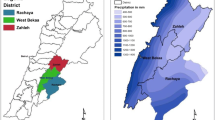Abstract
Land Degradation Neutrality (LDN) is a new approach, which is receiving considerable interest worldwide, in assessing current land condition. An LDN assessment was undertaken for the Dhahar-Jeffara transect in southeastern Tunisia. The assessment was performed following the United Nations Convention to Combat Desertification (UNCCD) method in terms of three indicators: land cover, land productivity and soil organic carbon. Over a 20-year period (1999–2018), satellite data, Geographic Information Systems (GIS), and Open Source applications were used to assess the changes in these indicators. As a result, the LDN baseline status was evaluated across the region to better understand its distribution, to evaluate trends as well as drivers of land degradation, and eventually identify “hot-spots”, targeted for restoration options and used to achieve the Sustainable Development Goal (SDG15.3) by 2030 in the studied area. The Trends.Earth tool under the QGIS software has been explored to support UNCCD-LDN indicators. Based on the three derived indicators, the majority of the study area (89%) showed clear stability toward the land degradation process. Only 3% (7330 ha) of the Dhahar-Jeffara transect were identified as degraded land areas; however, 8% (17860 ha) are identified as improved (not degraded) land. This study recommends the implementation of an LDN target setting at a regional level, in addition to targeting land degradation drivers behind the land degradation process by implementing different sustainable land practices to tackle this phenomenon.
Access this chapter
Tax calculation will be finalised at checkout
Purchases are for personal use only
Similar content being viewed by others
References
MEHAT: Atlas du Gouvernorat de Médenine. (Studies carried out by CRDA Médenine, 2010) Ministère de l’Equipement de l’Habitat et de l’Aménagement du Territoire of Tunisia (2012)
UN: United Nations. Revised list of global Sustainable Development Goal indicators. Report of the inter-agency and expert group on Sustainable Development Goal indicators (E/CN.3/2017/2) (2017)
Kust, G., Andreeva, O., Cowie, A.: Land degradation neutrality: concept development, practical applications and assessment. J. Environ. Manage. 195, 16–24 (2017)
UNCCD.: Good practice guidance: SDG indicator 15.3.1. Proportion of land that is degraded over total land area. Version 1.0. United Nations Convention to Combat Desertification (UNCCD), Commonwealth Scientific and Industrial Research Organisation (CSIRO) (2017)
UNEP/FAO: Land Degradation Assessment in Drylands (LADA) Project. Findings (2011)
Sghaier, M., Arbi, A. M., Tonneau, J. P., Ounalli, N., Jeder, H., Bonin, M.: Land degradation in the arid Jeffara Region, Tunisia. Land Use Policies Sustain. Dev.: Explor. Integr. Assess. Approaches, Edward Elgar 89 (2012)
Author information
Authors and Affiliations
Corresponding author
Editor information
Editors and Affiliations
Rights and permissions
Copyright information
© 2021 The Editor(s) (if applicable) and The Author(s), under exclusive license to Springer Nature Switzerland AG
About this paper
Cite this paper
Bayouli, O.T., Essifi, B., Ouessar, M. (2021). Assessing Land Degradation Neutrality (LDN) in Southeastern Tunisia Based on Earth Observation Data and Open Source Applications. In: Ksibi, M., et al. Recent Advances in Environmental Science from the Euro-Mediterranean and Surrounding Regions (2nd Edition). EMCEI 2019. Environmental Science and Engineering(). Springer, Cham. https://doi.org/10.1007/978-3-030-51210-1_289
Download citation
DOI: https://doi.org/10.1007/978-3-030-51210-1_289
Published:
Publisher Name: Springer, Cham
Print ISBN: 978-3-030-51209-5
Online ISBN: 978-3-030-51210-1
eBook Packages: Earth and Environmental ScienceEarth and Environmental Science (R0)




